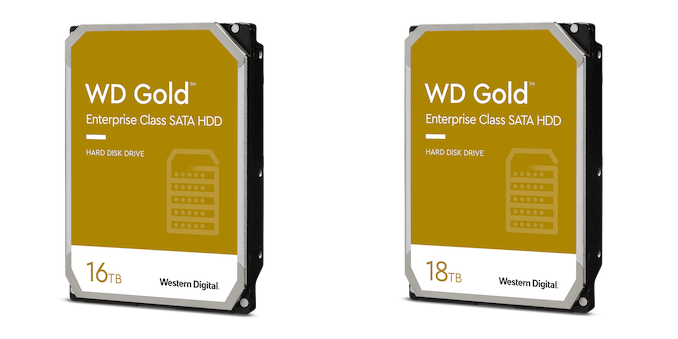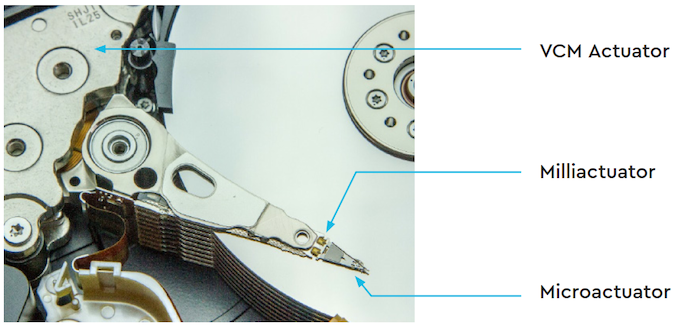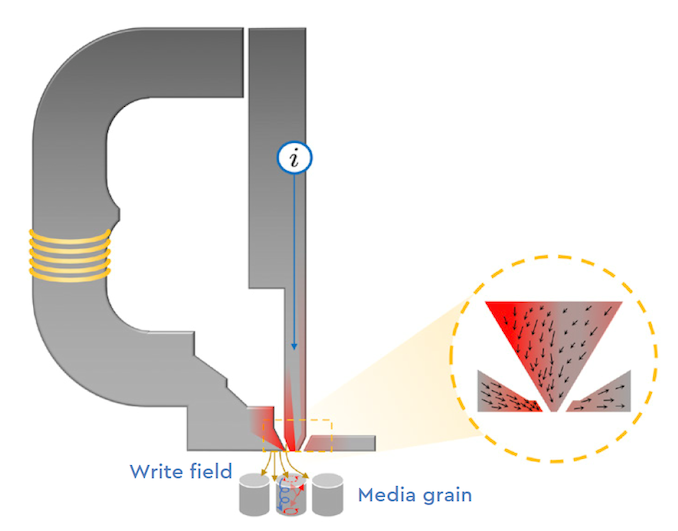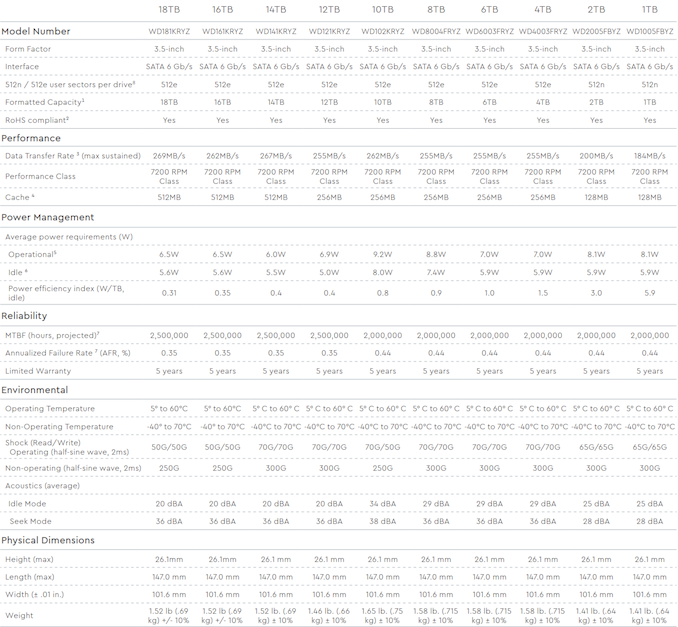Western Digital's 16TB and 18TB Gold Drives: EAMR HDDs Enter the Retail Channel
by Ganesh T S on July 9, 2020 8:00 AM EST- Posted in
- Storage
- HDDs
- NAS
- Western Digital
- MAMR
- Helium HDD
- HAMR
- CMR
- EAMR

Western Digital made a number of announcements yesterday related to their enterprise hard-disk drives (HDD) product lines. While there was nothing unexpected in terms of the products being announced, two aspects stood out - one was the retail availability of EAMR (energy-assisted magnetic recording) HDDs, and the other was additional information on the EAMR technology itself. In 2019, WD had announced the sampling of EAMR-based Ultrastar DC datacenter HDDs with 18TB and 20TB capacities. Yesterday's announcements build upon those products - the WD Gold-branded version of the Ultrastar DC CMR drives is now available for retail purchase, and the Ultrastar drives themselves have moved to general availability. The Ultrastar JBOD and storage server product lines have also been updated to utilize these new high-capacity drives.
Flash-based storage devices have taken over traditional consumer hard-drive application areas. However, increasing data storage requirements mean that HDDs still continue to be the most cost-effective solution for bulk storage. HDD vendors have been working on increasing hard drive capacities using multiple techniques. Around 10 years back, we had 2TB 3.5" HDDs with five PMR (perpendicular magnetic recording) platters in an air-filled enclosure. These drives were CMR (conventional magnetic recording) drives. In the last decade, we have seen advancements in three different categories that have enabled a 10-fold increase in the capacity of HDDs while retaining the same physical footprint:
Increasing the number of platters / making the platters thinner has been made possible by using sealed helium-filled enclosures. The reduced turbulence enables platters to be stacked closer to each other. The first-generation helium HDDs had 7 platters, and this has now grown to 9 platters for the new high-capacity drives.
The size of the writing head and the flexibility with which it can be manipulated dictate the minimum width of the recording tracks on the platters. Western Digital is claiming that they are the first to use a triple-stage actuator (TSA) in shipping HDDs.

The enhanced precision with TSA allows the TPI factor to go up. Incidentally, Seagate also has a novel actuator scheme (dual actuator), though that is aimed at increasing the throughput / IOPS.
One of the key challenges faced in the quest to increase the areal density of platters is the ability of the writing head to reliably alter the magnetic state of the grains in the tracks. Both heat-assisted magnetic recording (HAMR) and microwave-assisted magnetic recording (MAMR) are techniques that address this issue. In 2017, WD seemed set to go all-in on MAMR for their HDD product line, but three years down the road, we are looking at a variant that WD claims is a product of their HAMR and MAMR research - EAMR (energy-assisted magnetic recording).
While details were scant when EAMR was announced , WD is finally opening up on some of the technical aspects.

WD's first-generation EAMR technology (christened as ePMR) involves the application of electrical current to the writing head's main pole (this is in addition to the current sent through the voice coil) during write operations. The additional magnetic field created by this bias current ensures that the bits on the track alter their state in a more deterministic manner. In turn, this allows the bits to be packed closer together and increasing the areal density.
The above techniques can also be used with shingled magnetic recording (SMR) to boost areal density further. SMR has been around in both host-managed and drive-managed versions for a few years now. WD indicated in yesterday's announcement that qualification shipments of their 20TB Ultrastar DC host-managed SMR drive are in progress.

The WD Gold 18TB is available for purchase today and will set you back by $593. The 16TB version is priced at $528, but is currently out of stock. As is typical for enterprise drives, the two new models each have a MTBF of 2.5M hours, workload rating of 550TB/yr, and a 5 year warranty.
Source: Western Digital










69 Comments
View All Comments
burnte - Thursday, July 9, 2020 - link
Actually, fake news is about sources that completely make up information, such as the moon landing was staged, or JFK isn't dead, etc. When it came up in 2016 it was about sites that would publish articles that Obama was going to institute martial law rather than leave, or that the Pope endorsed Trump, or that RuPaul accused Trump of something. All of those were fake news.Inaccurate stories is something else. However, stating that we've seen a tenfold increase in capacity is either true or it's not. Not mentioning cost or other facts has no bearing on if there was a ten fold increase in capacity. Even if costs went up 100 fold, that doesn't negate an increase in capacity. There's a 100TB SSD available. It's $40,000 but it's AVAILA?BLE even if no one buys it.
FunBunny2 - Saturday, July 11, 2020 - link
"There's a 100TB SSD available. It's $40,000 but it's AVAILA?BLE"I remember STEC was the vanguard of high capacity, high cost (SLC) SSD ages ago. Who's making this sort?
Santoval - Friday, July 10, 2020 - link
You are trolling now aren't you?sonicmerlin - Saturday, July 11, 2020 - link
Can you stop polluting the comments section with your childish nonsense?StevoLincolnite - Thursday, July 9, 2020 - link
His point was that it came at a corresponding increase in price.nicolaim - Thursday, July 9, 2020 - link
A quick search turned up info up to 2017. It seems cost per TB almost stopped dropping around 2017, but there was a big decline 2009 - 2017.The lack of competition obviously is a factor, with only three remaining manufacturers.
Even if drives aren't getting cheaper per TB, being able to store more TB per rack saves money for data centers. WD claims increased reliability versus 1 - 10 TB drives, which also reduces TCO.
Lastly, HDD manufacturing is not a failing industry. Unit shipment decline is projected to end and turn into an increase soon.
Tomatotech - Thursday, July 9, 2020 - link
Low capacity HDDs are dead. HDD shipments are cratering. There are fewer and fewer HDDS being sold which means each individual HDD will have to bear a greater proportion of capital, ongoing, and research expense. The silver lining for HDD manufacturers is that the average price per HDD sold is soaring as hyperscalers and data storage warehouses are now the main purchasers of HDDs. This will lead to fewer and fewer new HDD models coming out suitable for home / individual use.Nicolaim, you said there is a projected increase in unit shipment. That isn't worth the paper it's written on until it actually happens. It might just be a gambit to raise some funding by a storage company. I found an assessment of global HDD shipments 1975-2025, released in May 2020. That rise in HDD shipments is projected to start in 2024, which means it's purely speculative and based on crossed fingers and wild fantasies. https://www.statista.com/statistics/398951/global-...
vortmax2 - Thursday, July 9, 2020 - link
"Nicolaim, you said there is a projected increase in unit shipment. That isn't worth the paper it's written on until it actually happens.""Unit shipment decline is projected to end and turn into an increase soon."
That's why they called a "projection" or in the finance industry an outlook, not an actual.
rahvin - Friday, July 10, 2020 - link
<HDD shipments are cratering.>This is categorically false. HDD shipments are at their highest level ever and still continuing to grow year over year. That you would argue such an incorrect and deliberately false statement indicates your lack of understanding of the market.
Most of the demand is cloud these days and there has big a drop in retail consumer use, but drive shipments remain as high as they've ever been.
s.yu - Saturday, July 11, 2020 - link
Then if anything $/GB should continue to fall, unlike this reality.